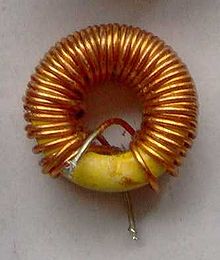- Magnet wire
-
Magnet wire or enameled copper wire is a copper or aluminum wire covered with thin insulation. It is used in the construction of transformers, inductors, motors, headphones, loudspeakers, hard drive head positioners, potentiometers, and electromagnets, among other applications. However, it is not itself magnetized.
The wire itself is most often fully annealed, electrolytically refined copper. Aluminum magnet wire is sometimes used for large transformers and motors. However, because of its lower electrical conductivity, an aluminum wire must have 1.6 times the cross sectional area as a copper wire to achieve comparable DC resistance. Smaller diameter magnet wire usually has a round cross section. Thicker magnet wire is often square or rectangular (with rounded corners) to permit more efficient use of available winding space. Older insulation materials consisted of cotton, paper, or silk and were only useful for lower temperature applications (up to 105°C).
Contents
Insulation
Modern magnet wire typically uses one to three layers of polymer film insulation, often of two different compositions, to provide a tough, continuous insulating layer. Magnet wire insulating films use (in order of increasing temperature range) polyvinyl formal (Formvar), polyurethane, polyamide, polyester, polyester-polyimide, polyamide-polyimide (or amide-imide), and polyimide. Polyimide insulated magnet wire is capable of operation at up to 250°C. The insulation of thicker square or rectangular magnet wire is often augmented by wrapping it with a high-temperature polyimide or fiberglass tape, and completed windings are often vacuum impregnated with an insulating varnish to improve insulation strength and long-term reliability of the winding.
Other types of insulation such as fiberglass yarn with varnish, aramid paper, kraft paper, mica, polyester film are also widely used across the world for various applications like transformers and reactors. In the audio sector, a wire of silver construction, and various other insulators, such as cotton (sometimes permeated with some kind of coagulating agent/thickener, such as beeswax) and polytetrafluoroethylene (Teflon) can be found.
Electrical Insulation System(EIS)
Basically, such systems are groups of materials that through extensive testing are recognized to be well suited for electrical applications at a given temperature or "class" and at specified material thicknesses.
Current density
In practice maximum current density can vary from 4A/mm2 for a wire isolated from free air to 6A/mm2 for a wire at free air. If the wire is carrying high frequency currents (above 10kHz) the skin effect may affect the distribution of the current across the section by concentrating the current on the surface of the conductor.
See also
Categories:
Wikimedia Foundation. 2010.

